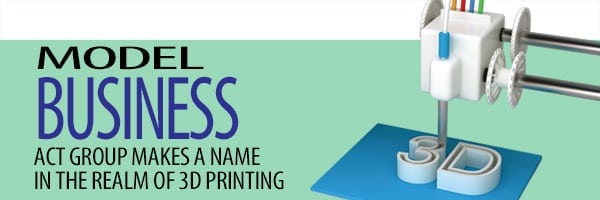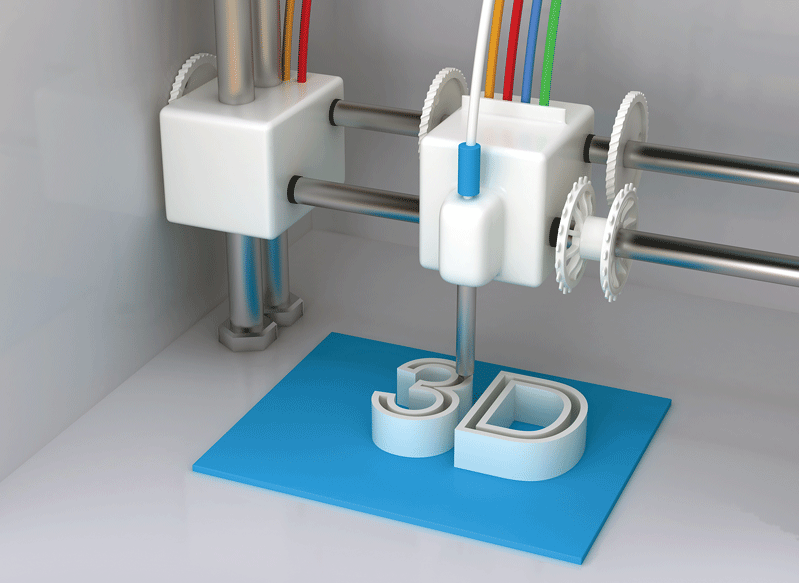
ACT Group Makes a Name in the Realm of 3D Printing
Model Business
3D printing is hardly a new development, but its applications have rapidly expanded over the past decade as companies use it to produce both inexpensive design prototypes and large runs of manufactured parts. Connecticut-based ACT Group has been at the forefront of this revolution regionally, selling and servicing 3D-printing equipment for a wide range of clients in myriad industries. Its success mirrors that of a technology that, clearly, is no longer flying under the radar.
When it comes to the capabilities and applications of 3D printing, Nick Gondek said, “the sky’s the limit.” Which is why he’s glad his company, ACT Group, has established a strong presence in that field.
Specifically, the firm — based in Cromwell, Conn. and formerly known as Advanced Copy Technologies — sells and services 3D printing equipment to a wide range of clients in fields as diverse as aerospace, medicine, and shoe manufacturing.
The company’s bread and butter, said Gondek, the company’s director of Additive Manufacturing and applications engineer, is a process called rapid prototyping, by which manufacturers can produce individual 3D models of potential products much more quickly and cost-effectively than previously possible.
Take, for example, ACT’s clients in shoe manufacturing, which include Timberland, New Balance, and Puma. Rapid prototyping using 3D printing — also known as additive manufacturing — can produce full-scale models of new designs, which can be easily modified numerous times at little cost, compared to making changes after manufacturing a large run.

Nick Gondek
“The technology has been around for some time, but flew under the radar,” said Gondek, whose parents, Greg and Cindi Gondek, purchased the company in 1999, when it focused solely on office-equipment supply. “Now it’s got everyone’s attention.”
They rebranded as ACT Group a couple of years ago to reflect a broadening in scope, including the company’s rise to prominence in the 3D-printing world.
“Five or six years ago, my father was traveling in Europe and was introduced to 3D printing,” Nick Gondek said. “After doing some research to better understand the clientele, he saw opportunity in this industry, on the service side of things.”
3D-printing technology allows users to create three-dimensional, solid objects using a computer-aided design (CAD) program. With a 3D printer, companies can now print a single part, or even complete product, in a matter of hours, when it used to take months. The technology can be used to create both precise, durable prototypes and final products for businesses of all sizes.
“We have a good customer base,” said Gondek, noting that ACT also services clients of 3D Systems, one of the nation’s premier 3D-printing companies, in the Northeast region.
The testimonials and success stories, as shared by Gondek with BusinessWest, are numerous. Daniel Copley, research and development manager at Parker Hannifin, which engineers products for industrial, hydraulic, and aerospace applications, said the company’s in-house 3D-printing capabilities reduced lead time for its prototypes as well as the number of iterations needed, and are saving some $250,000 a year in the cost of prototype parts.
Other clients have similar stories of efficiency and cost savings. Powermate, USA, a provider of power-supply-converting solutions, reports that prototype models of its products can be created in a half-day, with a 65% cost reduction over traditional production.
Meanwhile, John Reed, master prototype specialist at Black & Decker, noted that, “while a design may look good on the computer screen, there is really no substitute for actually holding something in your hand.”
Toby Ringdahl, computer aided design manager for Timberland, cited a dramatic reduction in prototype costs and turnaround time, resulting in more prototyping, better designs, and increased revenue, noting that 3D printing has succeeded in “compressing our design cycles, lowering our costs, and helping us produce better products for our customers.”
Expanding Scope
The 3D-printing process begins with a concept, which is digitally modeled using CAD software — in effect, creating a virtual blueprint of the object to be printed. The program then divides the object into digital cross-sections so the printer is able to build it layer by layer.
The manufacturer then chooses a material, which is sprayed, squeezed, or otherwise transferred onto a platform. The 3D printer makes passes over the platform, much like an inkjet printer, depositing very thin layers of material (each about one-tenth of a millimeter) atop each other to create the finished product.

ACT Group was formerly known as Advanced Copy Technologies, which focused solely on office equipment before expanding its scope, including its recent success with sales and service of 3D-printing equipment.
ACT first specialized in servicing this equipment for its client companies, but, not long after, saw opportunity in the sales of 3D printers, incorporating that end of the business as well.
Increasing numbers of manufacturers are turning to 3D printing, not only for prototyping, but for design, tooling, and delivery of parts and products. Cindi Gondek told Forbes that jewelers can use it to create new pieces, while museums can use it to reproduce rare items for study or display, just to name two applications that might not seem obvious at first.
3D printers can produce precision parts with impressive accuracy in a variety of materials, Nick Gondek said, including plastics, ceramics, wax, and metals.
Invisalign braces, manufactured by Align Technology, are a good example of a rapid-prototyping application most people have heard of, he went on. They are built using CT scanners and 3D printing techniques to fabricate a product that’s different for each user — to the tune of 17 million sets per year.
“Invisalign has a very unique production capacity. They have mastered customized production; every person’s braces are specific to that patient. They 3D print all the models and basically build a retainer over the custom-made molds,” he noted. Without the rapid prototyping allowed by 3D-printing technology, this process — and product — would be much more expensive and labor-intensive.
In fact, the broad field of medicine provides fertile soil for 3D printing, Gondek said, starting with the education and training of future doctors and other medical professionals.
“We have technologies that mimic the properties of human bone for pre-surgical practice, with students cutting bones, drilling bones … and we now have technology to mimic tissue as well, so we can cover them,” he explained.
The technology is also used for designing patient-specific braces and implants to mend broken bones and aid in surgery, Gondek added. “In the news, there’s a lot of talk about printing human tissue. No machine can print organs today, but that’s something that might become a possibility in five or 10 years.”
One ACT client is Maimonides Bone and Joint Center, which produces a 3D color bone model quickly and accurately from a CT scan. This 50% scale model helps doctors discuss medical issues with patients and assists with surgery practice sessions. “I found the 3D model invaluable in patient education, surgical planning, and physician training,” said the company’s Dr. Howard Goodman.
Meanwhile, Battelle Center for Mathematical Medicine developed a full-color 3D model of the F protein, which aided in the development of new perspectives on how respiratory syncytial virus (RSV) works, which promises to aid in vaccine research. “Even with prior access to stereo-3D monitors and professional graphics cards, nothing compares to a full-color, physical 3D model,” said Dr. William Ray, principal investigator and faculty member.
From the Ground Up
Additive manufacturing is also revolutionizing the architecture, engineering, and construction world, Gondek said, producing scale models of buildings faster and at lower cost than before, and allowing designers to make earlier decisions and reduce time to market.
Andrew Chary of Andrew Chary Architect PLLC, another ACT Group client, characterizes 3D printing as a natural outgrowth of building information modeling (BIM), which generates digital representations of buildings in the design phase. “BIM doesn’t reach its full persuasive potential on a computer screen,” he said. “The model comes to life when you hold a 3D print in your hands.”
The dominant material for prototyping is a liquid plastic that turns into a solid when exposed to UV light, Gondek explained. A ceramic material is typically used to mimic human bone, and any number of metals may be used when manufacturing industrial parts.
The move into 3D printing required some major shifts at ACT. The equipment involved in that realm is so different from the traditional office products the company sells that a dedicated team was established for 3D sales, service, and support. They were sent to MIT for professional education in the latest processes. “We couldn’t have their traditional 2D salespeople sell this equipment,” he explained. “The applications are too diverse.”
Thus, ACT Group continues to keep up with the latest 3D printing technology — a rapidly expanding field.
“We do our homework to a high extent so the customer fully understands the capacities as well as the limitations. We can’t be everything to everyone,” Gondek said. “But this is pushing the boundaries of what is possible.”
Joseph Bednar can be reached at [email protected]






